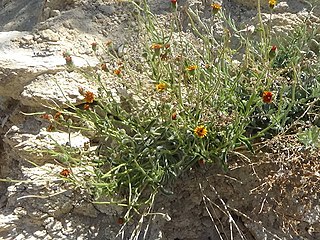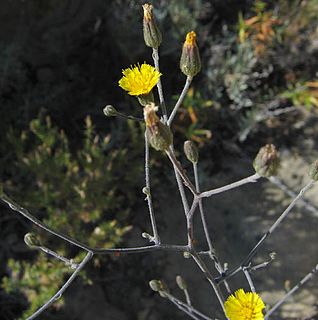
Coreopsis calliopsidea is a species of flowering plant in the daisy family known by the common name leafstem tickseed. It is endemic to California. The plant grows in some of the southern coastal mountain ranges and Transverse Ranges and the Mojave Desert from Alameda and Inyo Counties south to Riverside County.

Hulsea is a small genus of North American flowering plants in the family Asteraceae known commonly as alpinegold.

Geraea viscida is a species of flowering plant in the family Asteraceae known by the common name sticky geraea, or sticky desertsunflower. It is native to southern California, mainly the chaparral hills of eastern San Diego County, and nearby Baja California.
Holozonia is a North American genus of flowering plants in the family Asteraceae. It contains only one known species Holozonia filipes, which is known by the common name whitecrown. It is endemic to California.

Hulsea algida is a species of flowering plant in the daisy family, known by the common name Pacific hulsea or alpine gold.

Hulsea brevifolia is a species of flowering plant in the family Asteraceae known by the common name shortleaf alpinegold, or shortleaf hulsea. It is endemic to California, where it is an uncommon resident of the High Sierra. It is found between 6,000–8,000 feet (1,800–2,400 m) in elevation.
Hulsea californica is a rare species of flowering plant in the family Asteraceae known by the common names San Diego alpinegold and San Diego sunflower. It is endemic to southern California, where it grows only in the Peninsular Ranges.
Hulsea nana is a North American species of flowering plant in the family Asteraceae known by the common name dwarf alpinegold. It is native to the western United States from Washington, Oregon, and far northern California.

Hulsea vestita is a species of flowering plant in the family Asteraceae known by the common name pumice alpinegold.
Hymenoxys cooperi is a species of flowering plant in the daisy family known by the common name Cooper's rubberweed. It is native to the southwestern United States and Great Basin, where it grows in rocky soils in arid regions from southern California to New Mexico, north as far as Idaho and Oregon.
Senecio maranguensis a 2-meter (6 foot) woody shrub or 6 meter (20 feet) climbing shrub from the family Asteraceae and species of the genus Senecio which makes its home at the same altitudes as the bamboo on the slopes of the mountains in East Africa.
Arnica cernua is a species of arnica known by the common name serpentine arnica. It is native to the Klamath Mountains of northern California and southern Oregon, where it is a member of the serpentine soils flora.

Balsamorhiza deltoidea is a species of flowering plant in the sunflower tribe of the plant family Asteraceae known by the common name deltoid balsamroot. It is native to western North America from British Columbia to California, where it grows in many types of generally mountainous habitat.

Calycadenia multiglandulosa is a species of flowering plant in the family Asteraceae, known by the common names sticky calycadenia and sticky western rosinweed. It is endemic to California, where it is a common in the Coast Ranges and in the Sierra Nevada Foothills from Shasta County to Kern County.
Calycadenia pauciflora is a species of flowering plant in the family Asteraceae known by the common name smallflower western rosinweed. It is endemic to northern California, where it grows in the Coast Ranges north of the San Francisco Bay Area from Napa County to Tehama County.
Eriophyllum congdonii, known by the common name Congdon's woolly sunflower, is a rare California species of flowering plant in the family Asteraceae.

Hieracium argutum is a species of flowering plant in the aster family known by the common name southern hawkweed.
Harmonia hallii is a species of flowering plant in the family Asteraceae known by the common names Hall's harmonia and Hall's madia.

Blepharizonia is a genus of flowering plants in the family Asteraceae. There are two species, both endemic to California. They are known generally as big tarweeds.

Bahiopsis reticulata is a species of flowering plant in the family Asteraceae known by the common names netvein goldeneye and Death Valley goldeneye. It is native to the Mojave Desert of California and Nevada, where it grows in several types of dry desert habitat. Many of the populations are inside Death Valley National Park.











